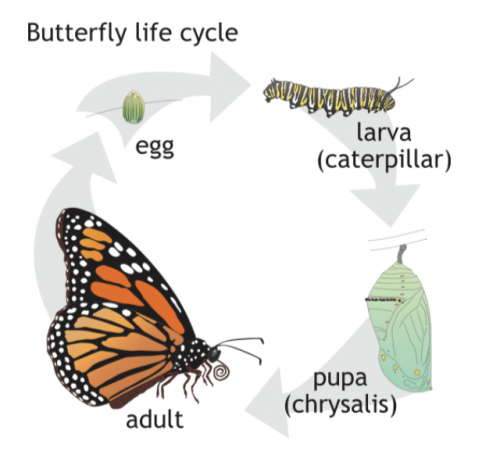Learn how to recognize and describe the stages of a butterfly life cycle.
Butterfly Life Cycle Activity Instructions
Ages: 5-8 years
Time Required: 20-30 minutes
Materials
- Activity Sheet (print or trace)
- Scissors
- Crayons and/or markers
Try This!
Step 1: Trace the shape and patterns from the activity sheet on a piece of paper or print the activity sheet.
Step 2: Cut out the traced shape, and flip it over to the blank side. Draw a butterfly pattern on this side (you can see an example on the activity sheet).
Step 3: Fold the butterfly in half along the long end to reveal the caterpillar and egg on one side, and the chrysalis on the other. You can color the caterpillar and then flip it and color the chrysalis.
Step 4: On the caterpillar side, if you fold the paper in half again on the short end, you will reveal the egg.
Step 5: When you unfold the paper, on the opposite side you will have the adult stage butterfly.
What’s Going On?
Metamorphosis is a series of major changes in an animal’s body form as it moves through its life cycle. Butterflies and moths undergo a complete metamorphosis, which means there are four separate stages in the life cycle (egg, larva, pupa, and adult). Each stage looks completely different and serves a different purpose in the life of the insect.
Egg Stage: Female Lepidoptera (the group butterflies and moths belong in) often require specific plants, called host plants, on which to lay eggs. A butterfly usually lays 200-500 eggs which vary in shape and size depending on the species. Most species hatch in four to five days, while others may take as long as three weeks.
Larva Stage: When the eggs hatch, tiny caterpillars begin feeding and growing. Its first meal is usually the eggshell, which provides it with important nutrients. Then it will begin eating the host plant. Almost all caterpillars eat leaves but some eat stems, roots, fruits, seeds, seed pods or flowers. They will eat only the host plant and will not move to any adjacent plant of a different species – even if it runs out of food. As they eat and their bodies expand, their skin (an exoskeleton with a limited stretching capacity) becomes tight and eventually splits and sheds, revealing new skin beneath. This is called molting and occurs several times as the larva grows.
 Pupa Stage: When the caterpillar has grown enough, it finds a protected spot, molts for the last time, and forms an encasement in which they metamorphose. During this stage, most moth caterpillars spin a silken cocoon while most butterfly caterpillars form a chrysalis. The pupa undergoes tremendous change. The caterpillar releases digestive juices that break down most of its body into a “tissue cell soup” from which it develops four wings, new legs, new eyes, new mouthparts, and genitalia. When the insect emerges, its metamorphosis is complete.
Pupa Stage: When the caterpillar has grown enough, it finds a protected spot, molts for the last time, and forms an encasement in which they metamorphose. During this stage, most moth caterpillars spin a silken cocoon while most butterfly caterpillars form a chrysalis. The pupa undergoes tremendous change. The caterpillar releases digestive juices that break down most of its body into a “tissue cell soup” from which it develops four wings, new legs, new eyes, new mouthparts, and genitalia. When the insect emerges, its metamorphosis is complete.
Adult Stage: The fully developed adult splits the pupal case open, crawls out and hangs upside down to facilitate stretching and drying its wings. Its wings are inflated by pumping fluid into the wing veins. At this stage, the wings are very soft and wet and the butterfly/moth must remain suspended while waiting up to two hours for its wings to dry. Once the wings are stretched and dried, the adult flies off to feed, find a mate and begin the cycle again. The average adult lifespan is two weeks but ranges from several days to as long as 11 months.
Extension Activity
The best way to observe any of the butterfly life cycle stages in the wild is to find a host plant. Learn what are the host plants of some of the species of butterflies you can find around your home. You can visit iNaturalist.org to see what butterflies you might have nearby and the host plants. Try planting some of these host plant species in your yard or go out to a park and find them to try to find a butterfly in any of the life cycle stages. If you are lucky you might find some eggs hidden underneath leaves, or caterpillars eating leaves, or a butterfly feeding or laying its eggs.